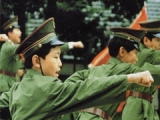The Children's Plight
Mar 2007
By Dana Landau for ISN
The most commonly agreed upon definition of a child soldier is based on the “Cape Town Principles” from 1997 and describes a child soldier as “any person under 18 years of age who is part of any kind of regular or irregular armed force or armed group in any capacity, including but not limited to cooks, porters, messengers and anyone accompanying such groups, other than family members. The definition includes girls recruited for sexual purposes and for forced marriage and does not, therefore, only refer to a child who is carrying or has carried arms.”
In 2006, the UN estimated that over 250,000 children served in armed groups as well as governmental armed forces in dozens of conflicts around the globe. According to the 2005 Human Security Report by the University of British Columbia, about one-third of child soldiers are serving in Africa. Despite most media attention focusing on child soldiering in Africa, this phenomenon is in fact a global one, with children actively participating in armed conflicts in Asia, Latin America, Europe and the Middle East. Countries in which children serve or have served in armed forces and groups include Afghanistan, Burundi, the Democratic Republic of the Congo, Liberia, Somalia, Uganda, Sri Lanka, Colombia, Chechnya, Myanmar, Nepal, Northern Ireland, the Philippines and Sudan.
An African study quoted in Peter W. Singer’s Children at War (2005) found that 60 percent of children under arms were 14 years old or younger and according to a 2006 United Nations University policy brief, up to 40 percent of the children associated with armed groups worldwide are girls.
The Coalition to Stop the Use of Child Soldiers has drawn attention to the fact that by being exclusively linked to participation in armed conflict, the number excludes a possibly equivalent number worldwide who have not been involved in armed conflict but are under 18, in uniform and have a formal army record.
Over the past decade, non-governmental organizations have successfully campaigned for the establishment of a legal framework prohibiting even the voluntary recruitment of under 18 year olds into armed forces and constituting the participation of children under 18 in combat a war crime.
The estimated number of 250,000 to 300,000 children have been continually involved in armed conflict since 1996. Hence, the number of young adults who experienced armed conflict as members of armed groups during their childhood is far higher, since, by definition, for the same person to be a child soldier today (as well as 10 years ago), the child would have to have been recruited at the age of seven. In fact, the relatively slight changes in numbers of child soldiers at any given moment during the last decade underlines the urgent need to end recruitment, the only measure by which child soldiers could effectively be made a phenomenon of the past within the next decade.

